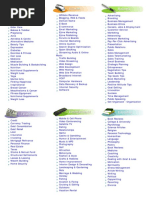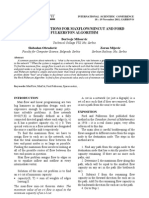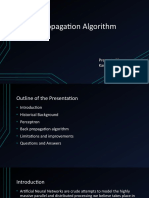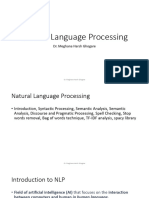Text Chunking Using NLTK
Uploaded by
VenkatMurthyText Chunking Using NLTK
Uploaded by
VenkatMurthyDongqing Zhu
What is chunking
Why chunking
How to do chunking
An example: chunking a Wikipedia page
Some suggestion
Useful links
recovering phrases constructed by the partof-speech tags
finding base noun phrases (focus of this tutorial)
finding verb groups, etc.
POS Tag
Information Extraction
keywords extraction
entity recognition
relation extraction
other applicable areas
What is an NP chunk
base NP
an individual noun phrase that contains no other
NP-chunks
Examples:
1. We saw the yellow dog. (2 NP chunks, underlined text)
2. The market for system-management software for
Digital's hardware is fragmented enough that a giant such as
Computer Associates should do well there. (5 NP chunks)
Trees
Tags
IOB tags ( I-inside, O-outside, B-begin)
label O for tokens outside a chunk
TREE File format:
(S
(NP the/DT
little/JJ yellow/JJ
dog/NN)
barked/VBD
at/IN
(NP the/DT
cat/NN))
IOB File format:
he RPR B-NP
Accepted VBD B-VP
The DT B-NP
Position NN I-NP
Two approaches will be covered in this tutorial
approach one: chunking with regular expression
approach two: train a chunk parser
Use POS tagging as the basis for extracting
higher-level structure, i.e, phrases
Key step: define tag patterns for deriving
chunks
a tag pattern is a sequence of part-of-speech tags
delimited using angle brackets
example: <DT>?<JJ>*<NN> defines a common NP
pattern, i.e., an optional determiner (DT) followed by any
number of adjectives (JJ) and then a noun (NN)
Define tag patterns to find NP chunks
# Python code (remember to install and import nltk)
sentence = [("the", "DT"), ("little", "JJ"), ("yellow", "JJ"), ("dog", "NN"), ("barked",
"VBD"), ("at", "IN"), ("the", "DT"), ("cat", "NN")] # a simple sentence with POS tags
pattern = "NP: {<DT>?<JJ>*<NN>}" # define a tag pattern of an NP chunk
NPChunker = nltk.RegexpParser(pattern) # create a chunk parser
result = NPChunker . parse(sentence) # parse the example sentence
print result
# or draw graphically using result.draw()
(S
(NP the/DT little/JJ yellow/JJ dog/NN)
barked/VBD
at/IN
(NP the/DT cat/NN))
More tags patterns/rules for NP chunks
determiner/possessive, adjectives and noun:
{<DT|PP\$>?<JJ>*<NN>}
sequences of proper nouns: {<NNP>+}
consecutive nouns: {<NN>+}
# define several tag patterns, used in the way as previous slide
patterns = """
NP:
{<DT|PP\$>?<JJ>*<NN>}
{<NNP>+}
{<NN>+}
""
NPChunker = nltk.RegexpParser(patterns) # create a chunk parser
Obtain tag patterns from corpus
Data from CoNLL 2000 Corpus (see next slide for how to load this corpus)
(NP UAL/NNP Corp./NNP stock/NN) # e.g. define {<NNP>+<NN>} to capture
this pattern
(NP more/JJR borrowers/NNS)
(NP the/DT fact/NN)
(NP expected/VBN mortgage/NN servicing/NN fees/NNS)
(NP a/DT $/$ 7.6/CD million/CD reduction/NN)
(NP other/JJ matters/NNS)
(NP general/JJ and/CC administrative/JJ expenses/NNS)
(NP a/DT special/JJ charge/NN)
(NP the/DT increased/VBN reserve/NN)
Precision-recall tradeoff
Note that by adding more rules/tag patterns, you may achieve high recall but the
precision will usually go down.
Use CoNLL 2000 Corpus for training
CoNLL 2000 corpus contains 270k words of WSJ
text
divided into training and testing portions
POS tags, chunk tags available in IOB format
# get training and testing data
from nltk.corpus import conll2000
test_sents = conll2000.chunked_sents('test.txt', chunk_types=['NP'])
train_sents = conll2000.chunked_sents('train.txt', chunk_types=['NP'])
# training the chunker, ChunkParser is a class defined in the next slide
NPChunker = ChunkParser(train_sents)
Define ChunkerParser Class
to learn tag patterns for NP chunks
class ChunkParser(nltk.ChunkParserI):
def __init__(self, train_sents):
train_data = [[(t,c) for w,t,c in nltk.chunk.tree2conlltags(sent)]
for sent in train_sents]
self.tagger = nltk.TrigramTagger(train_data)
def parse(self, sentence):
pos_tags = [pos for (word,pos) in sentence]
tagged_pos_tags = self.tagger.tag(pos_tags)
chunktags = [chunktag for (pos, chunktag) in tagged_pos_tags]
conlltags = [(word, pos, chunktag) for ((word,pos),chunktag)
in zip(sentence, chunktags)]
return nltk.chunk.conlltags2tree(conlltags)
Evaluate the trained chunk parser
>>> print NPChunker.evaluate(test_sents)
#IOB Accuracy: 93.3%
ChunkParse score:
Precision: 82.5%
Recall:
86.8%
F-Measure: 84.6%
# the chunker got decent results and is ready to use
# Note: IOB Accuracy corresponds to the IOB file format described in slide
Representation of chunk structures
Approach One
Pros: more control over what kind of tag patterns
you want to match
Cons: difficult to come up with a set of rules to
capture all base NP chunks and still keep a high
precision
Approach Two
Pros: high P/R for extracting all NP chunks
Cons: possibly need more post-processing to filter
unwanted words
Chunking a Wikipedia page
a Wikipedia page
BoilerPipe API
Plain text
file
POS
tokenization
tagging
tokenization
POS tagging
sentence
segmentation
chunking
keywords
extraction
a list of
keywords
Wikipedia page
BoilerPipe API
plain text
file
POS tagging
tokenization
sentence
segmentation
chunking
keywords
extraction
keywords
# Python code for segmentation, POS tagging and tokenization
import nltk
rawtext = open(plain_text_file).read()
sentences = nltk.sent_tokenize(rawtext) # NLTK default sentence segmenter
sentences = [nltk.word_tokenize(sent) for sent in sentences] # NLTK word tokenizer
sentences = [nltk.pos_tag(sent) for sent in sentences] # NLTK POS tagger
Wikipedia page
BoilerPipe API
plain text
file
POS tagging
tokenization
sentence
segmentation
chunking
keywords
extraction
keywords
for sent in sentences:
# TO DO LIST (already covered in a few slides ahead):
# 1. create a chunk parser by defining patterns of NP chunks or using the trained one
# 2. parse every sentence
# 3. store NP chunks
Wikipedia page
BoilerPipe API
plain text
file
POS tagging
tokenization
sentence
segmentation
chunking
keywords
extraction
keywords
# extract the keywords based on frequency
# a tree traversal function for extracting NP chunks in the parsed tree
def traverse(t):
try:
t.node
except AttributeError:
return
else:
if t.node == 'NP': print t # or do something else
else:
for child in t:
traverse(child)
Tag patterns used for this example: 1. {<NN>+}
Top unigram NP
chunks
(freq, term) pairs:
(118, 'iphone')
(55, 'apple')
(19, 'screen')
(18, 'software')
(16, 'update')
(16, 'phone')
(13, 'application')
(12, 'user')
(12, 'itunes')
(11, 'june')
(10, 'trademark')
Top bigram NP chunks
(6, 'app store')
(4, 'ipod touch')
(3, 'virtual keyboard')
(3, 'united kingdom')
(3, 'steve jobs')
(3, 'ocean telecom')
(3, 'mac os x')
...
2. {<JJ>*<NN>}
3. {<NNP>+}
Top NP chunks containing >2 terms
(3, 'mac os x')
(1, 'real-time geographic location')
(1, 'apple-approved cryptographic signature')
(1, 'free push-email service')
(1, 'computerized global information')
(1, 'apple ceo steve jobs')
(1, 'direct internal camera-to-e-mail picture')
Guess what the
title of this
Wikipedia page is?
If using approach one, define a few good tag patterns to
only extract things youre interested
e.g. do not include determiners
define tag patterns for n-gram (n<4)
If using approach two, do some post-processing
drop long NP phrases
Try to form a tag cloud by just taking frequent bigram
and trigram NP chunks, and use PMI or TF/IDF
information to prune a bit, and then add some unigrams
(remember you are only allowed to have no more than 15
tags)
Chapters from book Natural Language
Processing with Python
http://nltk.googlecode.com/svn/trunk/doc/book/ch05.html
http://nltk.googlecode.com/svn/trunk/doc/book/ch07.html
LingPipe does chunking in a very similar way
http://alias-i.com/lingpipe/demos/tutorial/posTags/read-
me.html
You might also like
- Full Download Getting Started with Natural Language Processing MEAP V06 Ekaterina Kochmar PDF DOCX100% (3)Full Download Getting Started with Natural Language Processing MEAP V06 Ekaterina Kochmar PDF DOCX55 pages
- Natural language processing with TensorFlow Teach language to machines using Python s deep learning library 1st Edition Thushan Ganegedara 2024 scribd download50% (2)Natural language processing with TensorFlow Teach language to machines using Python s deep learning library 1st Edition Thushan Ganegedara 2024 scribd download62 pages
- Engineering Design Knowledge Representation Based On Logic and ObjectsNo ratings yetEngineering Design Knowledge Representation Based On Logic and Objects19 pages
- Automatic Fault Detection System Using PLCNo ratings yetAutomatic Fault Detection System Using PLC26 pages
- An Introduction To Programming Physics-Informed Neural Network-Based Computational Solid MechanicsNo ratings yetAn Introduction To Programming Physics-Informed Neural Network-Based Computational Solid Mechanics32 pages
- How To Use An Existing DNN Recognizer For Decoding in KaldiNo ratings yetHow To Use An Existing DNN Recognizer For Decoding in Kaldi14 pages
- Data-Driven Modelling - Concepts, Approaches and Experiences0% (1)Data-Driven Modelling - Concepts, Approaches and Experiences15 pages
- Natural Language Processing: Artificial Intelligence Pyp 5No ratings yetNatural Language Processing: Artificial Intelligence Pyp 59 pages
- Full download Neural Networks A Visual Introduction for Beginners Michael Taylor pdf docx100% (1)Full download Neural Networks A Visual Introduction for Beginners Michael Taylor pdf docx65 pages
- Python Scikit-Learn Cheat Sheet For Machine LearningNo ratings yetPython Scikit-Learn Cheat Sheet For Machine Learning3 pages
- Matlab Solutions For Maxflow-Mincut and Ford Fulkerston AlgorithmNo ratings yetMatlab Solutions For Maxflow-Mincut and Ford Fulkerston Algorithm4 pages
- Feature Selection Techniques in Machine Learning - JavatpointNo ratings yetFeature Selection Techniques in Machine Learning - Javatpoint9 pages
- Artificial Intelligence: Computer Science EngineeringNo ratings yetArtificial Intelligence: Computer Science Engineering1 page
- Top 100 Deep Learning Interview QuestionsNo ratings yetTop 100 Deep Learning Interview Questions157 pages
- 3D U-Net Based Brain Tumor SegmentationNo ratings yet3D U-Net Based Brain Tumor Segmentation11 pages
- An A-Z of Useful Python Tricks - freeCodeCamp - Org - Medium PDFNo ratings yetAn A-Z of Useful Python Tricks - freeCodeCamp - Org - Medium PDF14 pages
- A Domain-Specific Automatic Text Summarization Using Fuzzy LogicNo ratings yetA Domain-Specific Automatic Text Summarization Using Fuzzy Logic13 pages
- Future Academy Machine Learning BrochureNo ratings yetFuture Academy Machine Learning Brochure14 pages
- (Excerpts From) Investigating Performance: Design and Outcomes With XapiFrom Everand(Excerpts From) Investigating Performance: Design and Outcomes With XapiNo ratings yet
- IMOmath - Functional Equations - Problems With SolutionsNo ratings yetIMOmath - Functional Equations - Problems With Solutions15 pages
- Violino 1 Signed, Sealed, Delivered - Stevie WonderNo ratings yetViolino 1 Signed, Sealed, Delivered - Stevie Wonder1 page
- Industrial Profile: Hutti Gold Mines Company LimitedNo ratings yetIndustrial Profile: Hutti Gold Mines Company Limited78 pages
- A New Radar Waveform Design Algorithm With Improved Feasibility For Spectral CoexistenceNo ratings yetA New Radar Waveform Design Algorithm With Improved Feasibility For Spectral Coexistence10 pages
- Components of The Smart Eye Glasses Price EstimationNo ratings yetComponents of The Smart Eye Glasses Price Estimation2 pages
- New Twists in The Unfolded Protein Response: Cell BiologyNo ratings yetNew Twists in The Unfolded Protein Response: Cell Biology4 pages
- Infection Prevention and Control (IPC) For COVID-19 VirusNo ratings yetInfection Prevention and Control (IPC) For COVID-19 Virus21 pages
- 3ms All Sequences Lesson Plans Worksheets Tutorial SessionsNo ratings yet3ms All Sequences Lesson Plans Worksheets Tutorial Sessions110 pages
- Full Download Getting Started with Natural Language Processing MEAP V06 Ekaterina Kochmar PDF DOCXFull Download Getting Started with Natural Language Processing MEAP V06 Ekaterina Kochmar PDF DOCX
- Natural language processing with TensorFlow Teach language to machines using Python s deep learning library 1st Edition Thushan Ganegedara 2024 scribd downloadNatural language processing with TensorFlow Teach language to machines using Python s deep learning library 1st Edition Thushan Ganegedara 2024 scribd download
- Engineering Design Knowledge Representation Based On Logic and ObjectsEngineering Design Knowledge Representation Based On Logic and Objects
- An Introduction To Programming Physics-Informed Neural Network-Based Computational Solid MechanicsAn Introduction To Programming Physics-Informed Neural Network-Based Computational Solid Mechanics
- How To Use An Existing DNN Recognizer For Decoding in KaldiHow To Use An Existing DNN Recognizer For Decoding in Kaldi
- Data-Driven Modelling - Concepts, Approaches and ExperiencesData-Driven Modelling - Concepts, Approaches and Experiences
- Natural Language Processing: Artificial Intelligence Pyp 5Natural Language Processing: Artificial Intelligence Pyp 5
- Full download Neural Networks A Visual Introduction for Beginners Michael Taylor pdf docxFull download Neural Networks A Visual Introduction for Beginners Michael Taylor pdf docx
- Python Scikit-Learn Cheat Sheet For Machine LearningPython Scikit-Learn Cheat Sheet For Machine Learning
- Matlab Solutions For Maxflow-Mincut and Ford Fulkerston AlgorithmMatlab Solutions For Maxflow-Mincut and Ford Fulkerston Algorithm
- Feature Selection Techniques in Machine Learning - JavatpointFeature Selection Techniques in Machine Learning - Javatpoint
- Artificial Intelligence: Computer Science EngineeringArtificial Intelligence: Computer Science Engineering
- An A-Z of Useful Python Tricks - freeCodeCamp - Org - Medium PDFAn A-Z of Useful Python Tricks - freeCodeCamp - Org - Medium PDF
- A Domain-Specific Automatic Text Summarization Using Fuzzy LogicA Domain-Specific Automatic Text Summarization Using Fuzzy Logic
- (Excerpts From) Investigating Performance: Design and Outcomes With XapiFrom Everand(Excerpts From) Investigating Performance: Design and Outcomes With Xapi
- IMOmath - Functional Equations - Problems With SolutionsIMOmath - Functional Equations - Problems With Solutions
- Violino 1 Signed, Sealed, Delivered - Stevie WonderViolino 1 Signed, Sealed, Delivered - Stevie Wonder
- Industrial Profile: Hutti Gold Mines Company LimitedIndustrial Profile: Hutti Gold Mines Company Limited
- A New Radar Waveform Design Algorithm With Improved Feasibility For Spectral CoexistenceA New Radar Waveform Design Algorithm With Improved Feasibility For Spectral Coexistence
- Components of The Smart Eye Glasses Price EstimationComponents of The Smart Eye Glasses Price Estimation
- New Twists in The Unfolded Protein Response: Cell BiologyNew Twists in The Unfolded Protein Response: Cell Biology
- Infection Prevention and Control (IPC) For COVID-19 VirusInfection Prevention and Control (IPC) For COVID-19 Virus
- 3ms All Sequences Lesson Plans Worksheets Tutorial Sessions3ms All Sequences Lesson Plans Worksheets Tutorial Sessions

























































































